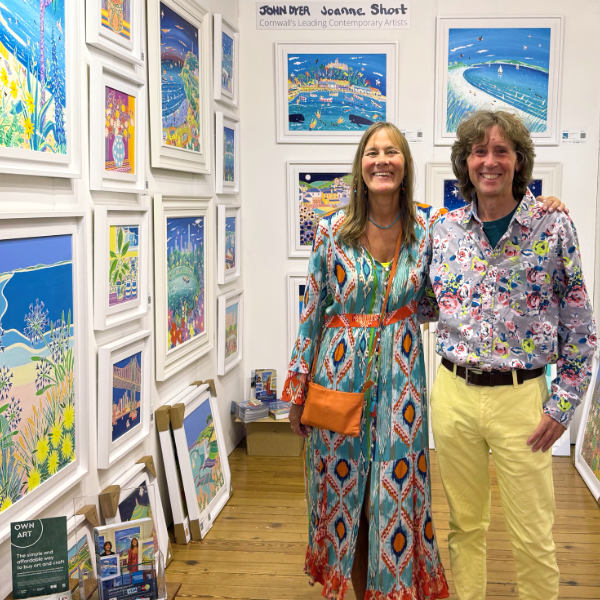Invest in British Art from Cornwall's Leading Artists | Free Worldwide Delivery
JOHN DYER
Original Paintings
New paintings available to buy online now by Cornwall's best loved artist.
JOANNE SHORT
Original Oil Paintings
New paintings available to buy online now by Cornwall's acclaimed colourist painter.
TED DYER
Original Oil Paintings
New paintings available to buy online by Cornwall's best known impressionist artist.
All Original Paintings
View all of the new original paintings that we have available to buy online now in our online gallery.
The ones you missed
View all of the recently sold original paintings by our Cornish artists John Dyer, Ted Dyer and Joanne Short.
Cornwall Art Prints
Museum-quality prints. Framed, Unframed, Signed & Wall Art Posters
Art T-Shirts, Hats & Hoodies designed in Cornwall. Eco-friendly. Free worldwide delivery.
Christmas Collection 2025
Stunning new painting collection by Cornish artists John Dyer & Joanne Short now available to view and buy.
Spirit of the Harvest | Eden Project
October 2025 - February 2026
New major John Dyer paintings inspired by global harvests, with field paintings from Peru, Costa Rica & the Philippines.
Colours of the South of France
New collection of French Riviera and Provence paintings by John Dyer opens on October 18th 2025.
Explore our Previous Exhibitions
Enjoy exploring our previous exhibitions online and discover extraordinary paintings you can own today.
Press Coverage and Testimonials
Art Collectors Club
Enjoy 5% off your first order, regular offers, exclusive exhibition invitations and artist and gallery updates in our email newsletter.
Gustav Klimt (1862-1918) was a leading Symbolist painter from Austria and a prominent figure in the Vienna Secession movement. Klimt was the second of seven children born in Baumgarten, near Vienna. His father, Ernst Klimt, was a gold engraver, and his mother, Anna Finster, aspired to be a musical performer. Klimt showed artistic talent early and, at the age of 14, enrolled in the Vienna Kunstgewerbeschule (University of Applied Arts Vienna), where he studied architectural painting.
Klimt began his career with his brothers and friend Franz Matsch, forming the "Company of Artists," which received commissions for public murals. In 1888, Klimt was awarded the Golden Order of Merit by Emperor Franz Josef I for his work on the murals in the Vienna Burgtheater. However, the deaths of his father and brother Ernst in 1892 profoundly impacted his life and art, leading him to develop a more personal and symbolic style.
In 1897, Klimt co-founded the Vienna Secession, a group that broke away from the traditional Vienna Artists' Association to promote artistic freedom and exhibit unconventional art. Klimt became the first president of the Secession, advocating for creative innovation and the inclusion of international artists in Viennese exhibitions. One of his notable works from this period is the "Beethoven Frieze," created for the group's 14th exhibition in 1902.
Klimt's "Golden Phase," which began around 1901, brought him critical and financial success. This period is characterised by the extensive use of gold leaf, influenced by Byzantine art and mosaics he saw in Venice and Ravenna. Masterpieces from this phase include "The Kiss" (1907-1908) and "Portrait of Adele Bloch-Bauer I" (1907), which are celebrated for their decorative richness and symbolic content.
Klimt's works often featured the female body and were marked by their eroticism and symbolism. His controversial murals for the University of Vienna, criticized for their explicit content, led him to withdraw from public commissions. Despite this, Klimt continued to explore themes of desire, dreams, and human emotion through his lush, symbol-laden paintings.
Klimt's personal life was unconventional. He maintained a lifelong relationship with fashion designer Emilie Louise Flöge and fathered at least fourteen children with various women. He preferred a reclusive lifestyle, focusing intensely on his art until he died in 1918.
Today, Klimt's legacy endures through his pioneering contributions to modern art, his role in the Vienna Secession, and his stunning, innovative works that continue to captivate audiences worldwide.
Explore our main art collections to find perfect original paintings, limited edition signed prints, open-edition prints, wall art prints and posters & artist designed gifts.
Exclusive access to exhibitions, new art, and collector news.
N.B. Please confirm your sign-up – check your email (or junk) and add sales@johndyergallery.com
I love these phone covers, always fit well and take the brunt of my phone carelessness! So nice to have beautiful artwork on the go, always cheers me up!
Small but beautiful. Their cheer gives me happy memories of my husband and my parents and lights up the room.
We first visited Holywell Bay about 10 years ago and absolutely fell with in love with the place.
So much so we've been lucky enough to visit back twice a year every year since. We first came across John work in St Ives a few years back and had
our eye on this painting for a while. It just captures everything we love about the beach. The joy, the sense of family, the feeling of the summer. The quality of the print is excellent. Feels and looks like the actual painting.
The quality of the print is excellent and
Thanks arrived safely and is now on display
I’ve bought this picture for my brother who lives looking out on Fistral Beach as it’s so quirky!
Just what we wanted..perfect.
We love visiting Fowey and this picture just shows the vibrancy and fun that we associate with Fowey . Makes us smile every time we look at this picture
A great print and fair price, promptly deivered. Thanks.
Bought this note book for my daughter. I know she will love it. Art work is stunning as always. The quality of the paper is excellent. My daughter will enjoy using it, and looking at a little bit of Cornwall every time she does.
Great quality t-shirt with the fabulous, gorgeous picture on it 😀
Joanne's use of colour and Cornish motifs make me smile.
Excellent mugs with great artwork
Wonderful paintings, lovely vibrant colours, really evocative of Cornwall, the anticipation of a different, fabulous image for the year to come is something to look forward to.
We’ll all be milwionaires
or not but we’ll have a bright and cheerful Dyer Calendar to gaze upon- love it
I get John’s calendars every year and this year is just as brilliant as always. Good quality, Quickly delivered and beautiful.




